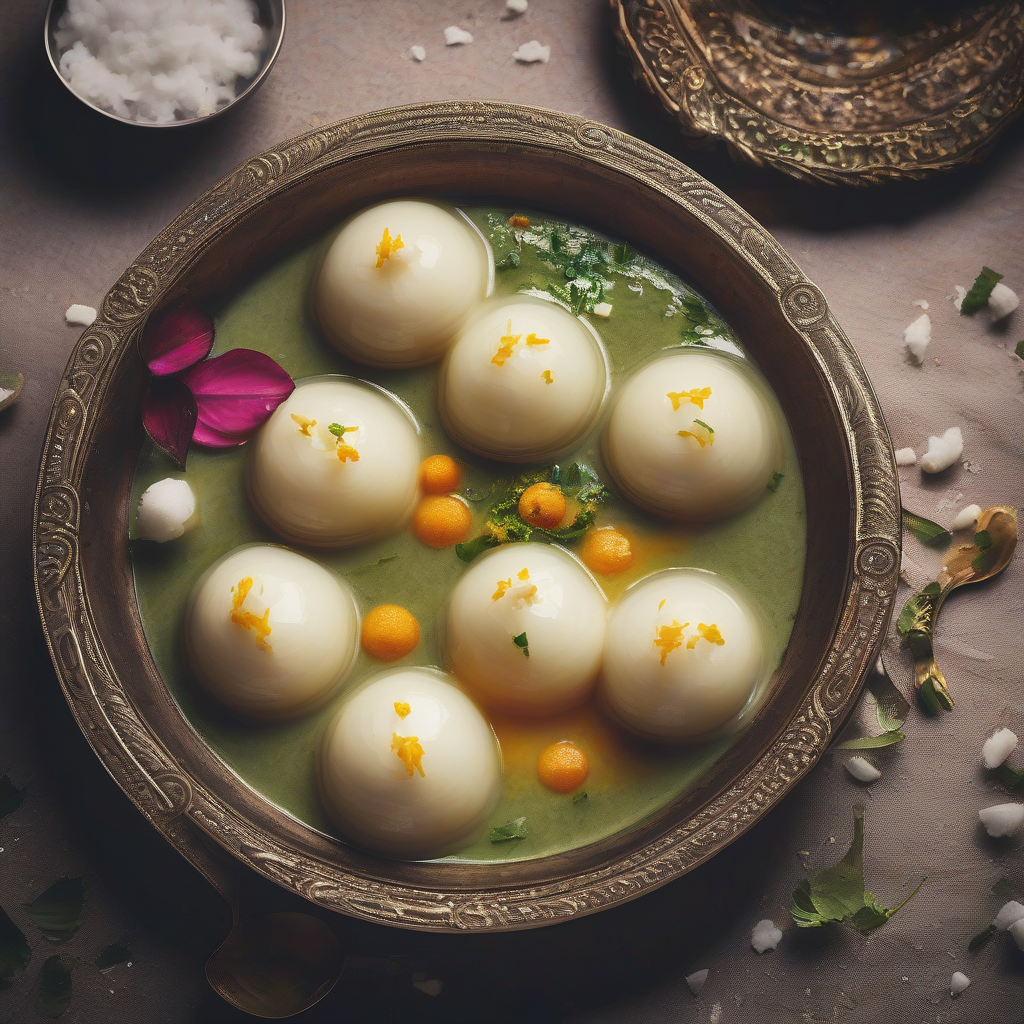Arey Wah! Pahari Rasgulla: Sweetness from the Hills!
Namaste, Mitron! And a big Jai Mata Di to all my Pahari friends! Chef Curry Do-Pyaza here, back with another delicious secret from the heart of India. Today, we’re journeying to the breathtaking hills of Himachal and Uttarakhand to uncover a sweet treasure: Pahari Rasgulla!
These soft, spongy cheese balls, swimming in a light, cardamom-infused syrup, are a staple in the hills. You’ll find them gracing tables during joyous occasions like Diwali, Dussehra, weddings, and even just a simple puja at home. They are especially popular during the cooler months, offering a warm, comforting sweetness that perfectly complements the crisp mountain air.
A Bite of History
Unlike its Bengali cousin, the Pahari Rasgulla boasts a rustic charm. It’s believed to have originated as a way for Pahari communities to utilize excess milk from their cows and goats. The recipe was passed down through generations, each family adding their own unique touch. The result? A delightful dessert that embodies the simplicity and purity of the mountains.
Get Ready to Cook!
Preparation Time: 20 minutes
Cooking Time: 30 minutes
What You’ll Need (Ingredients):
- For the Chenna (Paneer):
- 1 liter Doodh (Full Cream Milk)
- 2 tablespoons Nimbu ka Ras (Lemon Juice) or Sirka (Vinegar)
- For the Syrup:
- 2 cups Cheeni (Sugar)
- 4 cups Paani (Water)
- 2-3 Elaichi (Green Cardamoms), lightly crushed
- A pinch of Kesar (Saffron) strands (optional, for color and aroma)
Let’s Get Cooking!
- Making the Chenna (Paneer): In a big, heavy-bottomed pot, bring the doodh to a rolling boil over medium heat. Keep stirring so it doesn’t stick to the bottom.
- Once boiling, lower the heat and slowly add the nimbu ka ras or sirka. Stir gently until the milk starts to curdle and you see a clear, yellowish liquid separating from the solids.
- Turn off the heat. Line a colander with a clean muslin cloth (or cheesecloth). Pour the curdled milk into the cloth.
- Gather the edges of the cloth and gently squeeze out all the excess water. Rinse the chenna under cold water to remove any lingering lemon or vinegar taste. This step is very important!
- Hang the chenna in the cloth for about 15-20 minutes to drain completely. You want it to be moist but not wet.
- Kneading the Chenna: Take the drained chenna onto a clean, flat surface. Use the heel of your hand to knead it into a smooth, lump-free dough. This is crucial for soft, spongy rasgullas. Knead for at least 5-7 minutes until it’s as smooth as a baby’s cheek!
- Shaping the Rasgullas: Divide the chenna dough into small, equal-sized portions (about 1 inch in diameter). Gently roll each portion between your palms to form smooth, round balls. Make sure there are no cracks on the surface.
- Making the Syrup: In a large pot or pressure cooker, combine the cheeni and paani. Bring to a boil over medium heat, stirring until the sugar is completely dissolved.
- Add the crushed elaichi and kesar (if using) to the syrup.
- Cooking the Rasgullas: Once the syrup is boiling rapidly, gently drop the chenna balls into the syrup. Make sure there’s enough space between them so they can expand.
- Cover the pot and cook on medium-high heat for 15-20 minutes. If using a pressure cooker, cook for 2 whistles on medium heat.
- After the cooking time, turn off the heat and let the rasgullas cool completely in the syrup. This allows them to absorb the sweetness and become even more spongy.
Chef’s Tips for Lajawab Results!
- Fresh Milk is Key: Always use fresh, full-cream milk for the best chenna.
- Don’t Overcook: Overcooking will make the rasgullas hard and rubbery.
- Gentle Handling: Be gentle while kneading and shaping the chenna to avoid cracks.
- Patience is a Virtue: Let the rasgullas cool completely in the syrup for maximum flavor and sponginess.
Cooking it Your Way!
- Gas Stove: Follow the steps above for the most traditional method.
- Induction Stove: Adjust the heat settings accordingly to maintain a steady boil.
- Pressure Cooker: Cook for 2 whistles on medium heat. Release the pressure naturally.
- Oven: I don’t recommend baking rasgullas.
- Microwave: I don’t recommend microwaving rasgullas.
- Air Fryer: I don’t recommend using an air fryer for rasgullas.
- Slow Cooker/Crockpot: While possible, it’s not ideal. The precise temperature control of a stovetop is preferred.
Nutritional Information (Approximate, per Rasgulla):
- Calories: 80-100
- Carbohydrates: 15-20g
- Protein: 2-3g
- Fat: 1-2g
Serving Suggestions:
- Serve chilled or at room temperature.
- Garnish with chopped nuts like pistachios or almonds for a festive touch.
- Enjoy them on their own or with a scoop of vanilla ice cream for an extra indulgent treat.
Khao, Piyo, Khush Raho!
There you have it, folks! My simple yet sensational recipe for Pahari Rasgulla. I urge you to try this at home and experience the delightful flavors of the mountains. Share these sweet delights with your friends and family, and spread the joy!
Until next time, Alvida! And happy cooking!
